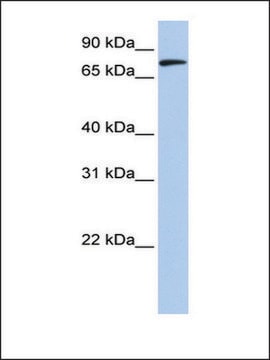M6319
Anti-Mitofusin-2 (N-Terminal) antibody produced in rabbit
affinity isolated antibody, buffered aqueous solution
Synonym(s):
Mitofusin 2 Antibody, Mitofusin 2 Antibody - Anti-Mitofusin-2 (N-Terminal) antibody produced in rabbit, Anti-CMT2A, Anti-CMT2A2, Anti-CPRP1, Anti-KIAA0214, Anti-MARF, Anti-Mfn2
About This Item
Recommended Products
biological source
rabbit
conjugate
unconjugated
antibody form
affinity isolated antibody
antibody product type
primary antibodies
clone
polyclonal
form
buffered aqueous solution
mol wt
antigen ~86 kDa
species reactivity
mouse, human, rat
technique(s)
immunoprecipitation (IP): 5-10 μg using HeLa human epitheloid carcinoma cell lysate
indirect immunofluorescence: 20-30 μg/mL using differentiated mouse C2 cells
western blot (chemiluminescent): 0.5-1 μg/mL using extracts of rat or mouse brain mitochondria
UniProt accession no.
shipped in
dry ice
storage temp.
−20°C
target post-translational modification
unmodified
Gene Information
human ... MFN2(9927)
mouse ... Mfn2(170731)
rat ... Mfn2(64476)
General description
Specificity
Immunogen
Application
By immunoblotting, a working antibody concentration of 0.5-1 mg/mL is recommended using an extracts of rat and mouse brain mitochondria and a chemiluminescent detection reagent.
By indirect immunofluorescence, a working antibody concentration of 20-30 mg/mL is recommended using differentiated mouse C2 cells.
5-10 mg of the antibody immunoprecipitates mitofusin 2 from HeLa human epithelioid carcinoma cell lysate.
Western Blotting (1 paper)
Physical form
Disclaimer
Not finding the right product?
Try our Product Selector Tool.
related product
Storage Class Code
12 - Non Combustible Liquids
WGK
WGK 1
Flash Point(F)
Not applicable
Flash Point(C)
Not applicable
Certificates of Analysis (COA)
Search for Certificates of Analysis (COA) by entering the products Lot/Batch Number. Lot and Batch Numbers can be found on a product’s label following the words ‘Lot’ or ‘Batch’.
Already Own This Product?
Find documentation for the products that you have recently purchased in the Document Library.
Our team of scientists has experience in all areas of research including Life Science, Material Science, Chemical Synthesis, Chromatography, Analytical and many others.
Contact Technical Service






